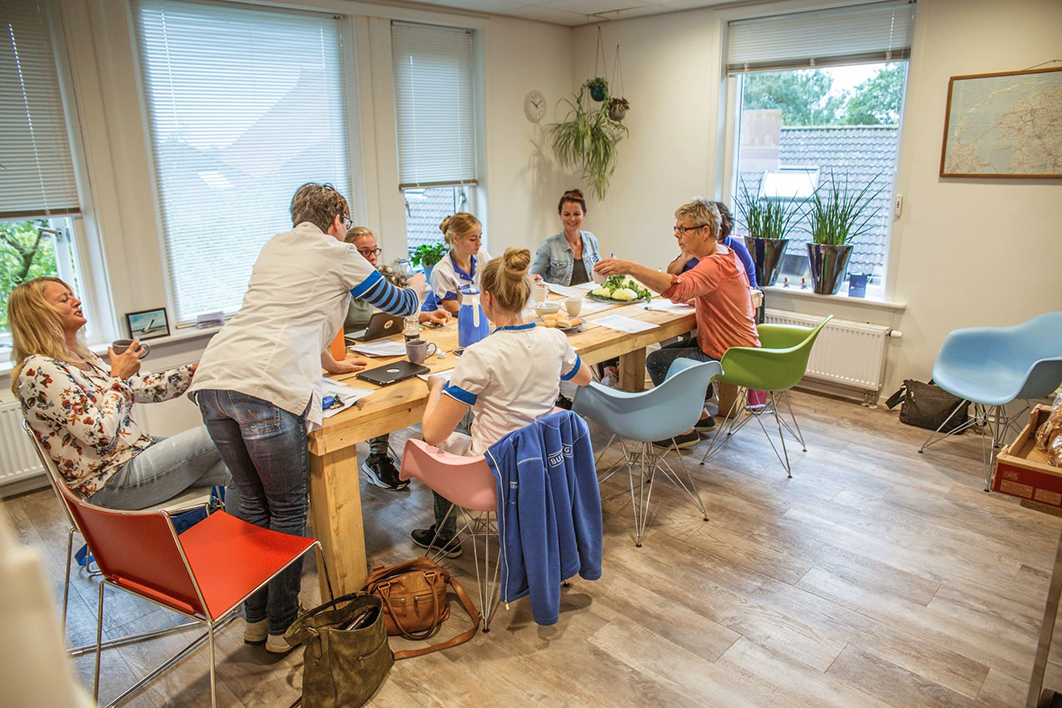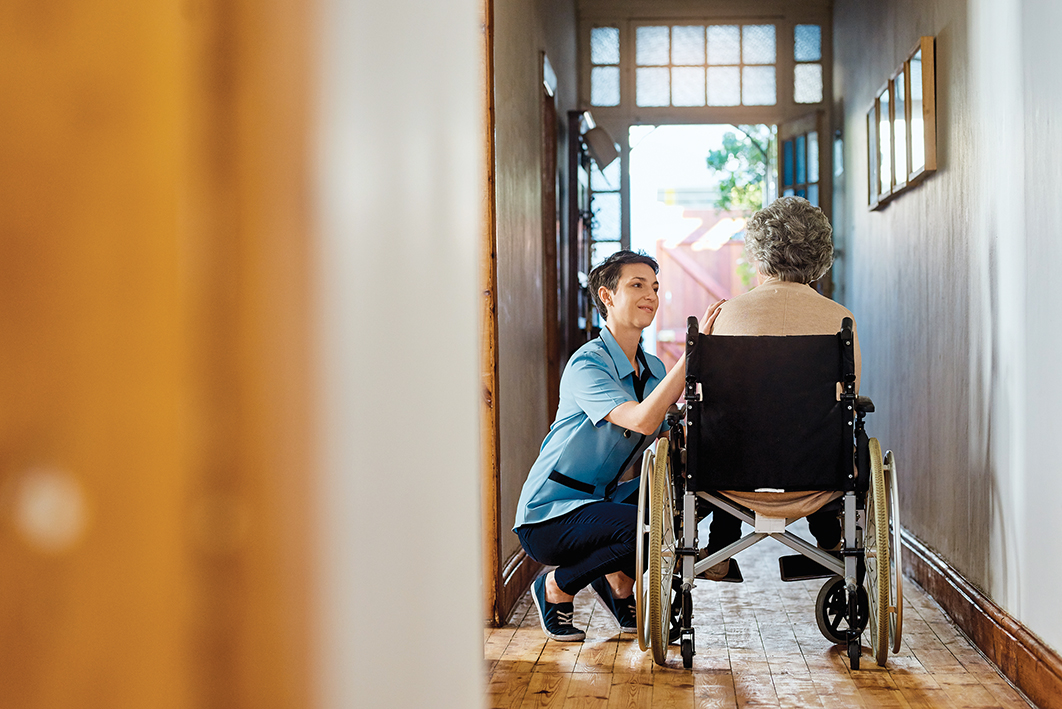Last October, when it looked as though Western Australia had dodged the worst of the pandemic, a fledgling organisation called Neighbourhood Care put its first team into the field, offering support to people with disabilities living independently at home. It pitched its new services with a genial offer of “Coffee first, then care.”
I’m not sure how many people in Perth picked up the clue in that refrain, but those who did would have known that something distinctively Dutch was brewing. That phrase is the call sign of Buurtzorg (spoiler: in Dutch buurt means neighbourhood and zorg means care), a nurse-led organisation that has revolutionised home care in the Netherlands.
Buurtzorg intrigues policymakers around the world looking for better ways to enable elderly people (and others with care needs) to live independently with less formal care. What’s not to like about a model that KPMG found “halves costs, improves quality and makes happier caregivers,” as Forbes magazine enthused?
Admirers of the Buurtzorg model are not confined to healthcare, either. La philosophie Buurtzorg, as the French call it, has become something of a standard-bearer for a nascent movement rallying to put human values back at the core of government.
Neighbourhood Care — which is indeed Buurtzorg’s partner in Australia — launched under the radar, in difficult times. At first glance, it appears to be just another service provider competing for dollars under the National Disability Insurance Scheme. And, who knows, that may yet prove to be so. There’s plenty of noise in that crowded space, and good reason to suspect the fine intentions of new entrants. “A lot of people come into the sector with lovely values and mission statements, but they are there for an opportunity, to commodify care,” says Wollongong University health services researcher Anita Westera, who points to the rapid growth of digital care platforms like Mable and Kynd as the logical extension of transforming aged care and disability into a marketplace predicated on consumer choice.
Chief executive Arnold Stroobach tells me Neighbourhood Care employs twenty-six people. It has three teams operating in Western Australia — two in metropolitan Perth and another in Northam, an hour east of Perth — and a small presence in Ipswich, in Queensland. These self-managed teams are the central unit of the Buurtzorg model; in the Netherlands, where it is the biggest community care provider, Buurtzorg’s decentralised network has 1000 of them.
A Buurtzorg team consists of ten to twelve trained nurses. Once a team grows bigger than twelve, it splits into two (an idea pinched from an unconventional Dutch tech entrepreneur, the late Eckart Wintzen). Each nursing team works in a buurt of up to 10,000 inhabitants and typically divides the care of fifty to sixty frail elderly people between its members. Referrals come from hospitals, doctors or families.
The nurses organise everything themselves, taking charge of the complete process of caring for their patients and running their own small enterprise. They are connected to each other and the other teams in the decentralised network by an internet-based platform called Buurtzorgweb. There’s no middle management to refer problems up to. If a team has internal conflict, Buurtzorg offers the assistance of “coaches” — there’s one per forty teams — who are trained in team dynamics. If a team can’t solve its problems, it closes.
Neighbourhood Care bears only a sketchy resemblance to this model at the moment. Apart from working in disability rather than aged care, only one team is operating at full capacity, the one in Northam, and its employees are not nurses but therapists and trained support workers. The challenge for the organisation is to comply with the requirement of the NDIS — where every client has a plan with prescribed goals and line items — while trusting the operation to the team.
“You can’t copy and paste the Dutch model,” says Stroobach. “You have to find a way to adapt to local conditions.” The team dynamic is different in a non-medical sector, he says, but they haven’t changed the principles of Buurtzorg a lot. And they’ve just passed their first NDIS audit. The next step is to register for the federal government’s My Aged Care scheme.
Australia’s sprawling suburbs and isolated regional towns are a very different kind of buurt from those in the Netherlands’ densely populated lowlands. But Buurtzorg’s big idea is small teams not small areas, Stroobach says. “It’s human-scaled.” It has been a slow business finding the right people for the teams, frontline workers who know what’s expected of them and can wear the responsibility of self-management. The Dutch love it, but it’s not a familiar concept in Australia, where our default position is the traditional hierarchy.
Stroobach finds the analogy with a sporting team works well though. “In sport, feedback can be brutal, but it’s acceptable. In the workplace here it’s almost a miracle to have feedback.” And some clients aren’t comfortable with the Buurtzorg model — they don’t believe the support worker can make his or her own decisions. It’s a tricky dynamic, he says, and “you can kill it off if you’re not careful.”
When I speak with Buurtzorg’s founder, nurse turned social entrepreneur Jos de Blok, he seems happy enough with what’s happening in Australia so far. “In my opinion, they are doing very well,” he says. It’s quite an effort in the first few years, he adds. The thing is to break even: “If it is stable, you can easily grow.” He thinks it will take five years for Buurtzorg to “get somewhere” in Australia.
That’s an interesting time frame, given the speed and magnitude of Buurtzorg’s growth in the Netherlands. From a standing start in the winter of 2006, Buurtzorg attracted enormous interest, both from nurses who deserted its competitors to join Buurtzorg teams, and from the ministry of health, which actively promoted the development of the model.
Within a decade, Buurtzorg was employing more than half the country’s community nurses, and the government had adjusted the payment system to make room for its flat-rate billing. By 2015, two independent audits (by KPMG and EY) had assessed the model’s impact on some of the most chronic problems facing Dutch healthcare — dissatisfied patients, overstretched and disillusioned staff, and a constant pressure on budgets. Those reports were immensely helpful, de Blok says. “When you are able to show that our model is 40 per cent cheaper for society, you get political acceleration.”
Buurtzorg employs more than 14,000 people in the Netherlands. It is mostly engaged in nursing frail elderly people in their homes, but it also has teams working in mental health, family and child services, and domestic help, and there is discussion in the Netherlands and elsewhere about whether and how the Buurtzorg principles can be applied to education, policing and other social services. De Blok doesn’t argue with that. “For me, it is not really a business model, it is a way to look at society,” he says.
De Blok is driving while we talk, heading to The Hague for a meeting with the Dutch health minister. It’s a Monday morning, but traffic is light. He’ll be on time, which is a good thing because Hugo de Jonge is “not particularly a friend,” he says. Previous ministers of health have been helpful, but de Jonge has been critical of Buurtzorg. Plus, he has a “top-down way of doing things.” You can see where this is going. Top-down would press all de Blok’s buttons.
But he’s not necessarily meeting his minister as a supplicant. The Buurtzorg model is one of the Netherlands’ more famous exports these days — perhaps not up there with edam or windmill biscuits, but active in twenty-five countries. Moreover, a lot of Buurtzorg’s competitors have adopted its model. De Blok estimates up to 70 per cent of healthcare organisations in the Netherlands have switched to self-managed teams. “My ambition in Holland was to change the healthcare system,” he says. “We succeeded quite well.”

Reducing complexity: Buurtzorg’s founder, Jos de Blok. Linelle Deunk/Lumen
He has no need to blow his own trumpet when so many others are ready to do it for him. Frederic Laloux devoted a section of his influential management book Reinventing Organizations to Buurtzorg’s model; the Royal Society of Arts awarded de Blok its Albert Medal in 2014 (other recipients have included Francis Crick and Tim Berners-Lee). The young Dutch historian who famously disrupted the 2019 Davos meeting, Rutger Bregman, is a fan. The list goes on. De Blok and his organisation are a global phenomenon.
The minister would know that. He would also know that everything has its season. Has Buurtzorg already fulfilled the potential that Dutch management professor Sharda Nandram suggested it had “to permanently change the landscape of the healthcare sector” or is it only just hitting its stride? It’s hard to know. There are still a lot of blanks in the picture.
Buurtzorg is de Blok’s brainchild and he is a gifted communicator, in an understated Dutch way. If you watch him giving a TED talk, it isn’t difficult to appreciate why his ideas have such a wide reach, not just in Europe but in places where Dutch ideas have historically had little purchase, like China, India and Japan.
He makes eliminating overpaid managers, luxurious offices and layers of bureaucracy — and giving teams of nurses the authority and responsibility for providing care to housebound older people with chronic disease and disabilities — sound incredibly obvious.
De Blok is no innocent. It’s not that he doesn’t see the problems that healthcare systems all over the world have — who doesn’t? — but rather that he makes a virtue of reducing complexity.
“What I see in a lot of countries is that systems are increasingly complicated and frustrations are becoming worse and worse,” he told University of Cambridge business professor Jaideep Prabhu, whose new book about government tells the Buurtzorg story in detail. “I want to show that it’s easy to change.”
But that’s the question, isn’t it? How easy?
It’s worth spending a little time looking more closely at how Buurtzorg developed in the Netherlands before exploring why full take-up of the model has not quite happened yet — even in Britain, where enthusiasm for Buurtzorg is high, as former Buurtzorg staffer Paul Jansen wrote recently, but many promising teams have been absorbed back into their organisations. Jansen was chief operating officer at Buurtzorg Britain and Ireland between 2018 and 2020.
Much of the intense international curiosity and speculation about Buurtzorg centres on the question of its adaptability. Can its successes be replicated in countries with similar healthcare problems, or is it something that only the Dutch, with their famous openness to new ideas (like reinstating old water courses to avert extreme flooding, and demanding farmers cull their cow herds to reduce ammonia pollution), can pull off?
So, a short detour is needed to put Buurtzorg’s origins into context. In the early 1990s, in response to rising costs and an ageing population, Dutch politicians threw away the old public service playbook and put their faith in the three Ms of markets, managers and metrics. Even if you’re not a student of government — who would know this trend as New Public Management — you’ll recognise the ideological shift. It changed the way public services throughout the world were delivered, and nowhere more so than in Australia, where NPM retains an iron grip across government.
De Blok was working in a village with a few colleagues as a community nurse when the political winds changed. He told the journal People and Strategy that being a community nurse under the traditional, pre-NPM model of healthcare gave him everything he wanted. “I had the freedom to decide how to take care of patients. I had very good colleagues. There was no management structure, we didn’t have strategic plans, and we didn’t have planning tools. We just did what was needed. It was effective.”
And then came a directive from the top that small district nursing teams should be merged to form larger organisations run by professional managers. This would bring economies of scale, with competition driving down costs and driving up the quality of care.
That was the theory. What actually happened was that the focus of healthcare moved from caring for patients to delivering products — products like nursing, nursing extra, personal care, personal care special, guidance, guidance extra, and so on. As products proliferated, more managers were hired to control the process.
Nurses, on the other hand, were authorised only to deliver certain products in an agreed time frame and lost the personal bond they’d had with patients. Sometimes up to thirty different healthcare professionals visited an elderly person at home in a month to administer different tasks or interventions, yet there was no oversight of an individual’s health and wellbeing.
(Melbourne public health researcher Sarah Russell has made similar observations about My Aged Care, where the most common complaint about providers is the high turnover of unqualified, inexperienced and untrained support workers, strangers being sent to the homes of older people who have to “just trust they will be treated with respect and kindness.”)
Care organisations became like factories, systems replaced relationships, and the perception of what was good care and what were good solutions changed — but to what end? Patients were confused and unhappy. Nurse sick leave rates soared. And, instead of driving down costs and improving the quality of care, the reforms had the opposite effect.
De Blok spent a decade trying to work within the new system. He retrained as a manager, did a master’s degree in innovation and eventually became a managing director. But by 2004 he understood that if he wanted to recover what had been lost — the sacrosanct relationship between patient and nurse — he’d have to start his own organisation, designed and run by nurses. It would deliver only one service, which was helping people in the quality of their daily life.
The idea, de Blok has said, was to “have people around these problems who feel connected to them and can make the choices they think are the best choices… The support systems should be logical and simplified but you should not underestimate the complexity of what’s going on.”
To understand that complexity better, listen to him talking to Richard Atherton on the Being Human podcast about the kinds of decisions nurses make when they’re caring for patients in the last phase of their life. “In our society, we try to make everything explicit, we try to put it into protocol and regulations and so on, but most of the work of nurses is in the heads of people, based on years of doing things and understanding patterns. You need the environment, you need the autonomy, and the space to do these things based on your practical wisdom and intuition.”

Feeling connected: a Buurtzorg team meeting in the German city of Münster. Buurtzorg Germany
De Blok spent eighteen months designing Buurtzorg with his wife Gonnie Kronenberg and other nursing friends. He had figured out most of it, but it wasn’t until he got talking to a former colleague and IT expert, Ard Leferink, that the model came together. Leferink showed him how to scale up his idea. He would design an internet-based platform (which became Buurtzorgweb) that could be built quickly and cheaply to support nurses in their work, freeing up their time to focus on care.
Nursing teams manage their frontline workload on their iPads (the platform also allows Buurtzorg to monitor how each team is doing), and other administration is picked up by the back office operation run by Kronenberg. It’s lean: forty-five people deal with contracts, billing hours to health insurers, and supporting nurses when they have difficult cases. Overheads are low, at 8 per cent. In Australia, administration fees in the home care system average almost a third of package costs.
In its first full year of operation, 2007, Buurtzorg began with one team of ten nurses in Almelo and ended the year with twelve teams in different places and a turnover of €1 million. De Blok wasn’t surprised. He knew that if it worked then everyone would want it. It was good for nurses, good for patients, and — as would be proven within a few years — good for the system. But they did get lucky.
In the summer of 2007, the then minister of health, who’d seen de Blok on television, asked if she could join a team of Buurtzorg nurses on her bicycle. She liked what she saw and invited Buurtzorg to visit the ministry of health, and from there came an initiative that led to Buurtzorg being asked to develop a national policy based on its model. “She was wanting to find ways to change [the system] herself,” he remembers. “So she said, ‘Let’s do this together.’” Not everyone was convinced, though. There was some pushback from other care organisations and from insurers, which withheld funds, but eventually they came on board.
That’s the conundrum: people around the world like what they see in Buurtzorg, and want what it offers, but on their terms. People in top government roles can have big issues with trust and relinquishing control. “There is a lack of trust in devolving power and funding to communities that know their people best,” says Travers McLeod, chief executive of the Centre for Policy Development in Melbourne, which has invested a lot of thought and energy on the ground in community-led programs.
Trust-based organisations like Buurtzorg are difficult beasts to understand if your view is that people are fundamentally selfish. That was the starting point of NPM — that people need tangible incentives to serve the public good, which means their performance has to be measured so managers know who deserves punishment or reward. And people who ask for help must be assessed to see if they really need help, or are just trying to grab more than their share.
We’ve all grown used to thinking this way, so it’s hard work persuading policymakers that other motivations can bring out the best in people.
“Working within a system that is not open to these kinds of things is one of the most difficult parts,” de Blok tells me. “I’ve been talking for ten years with the NHS [Britain’s National Health Service]. It is so complicated in that system to create space and an environment where you can experiment and show an impact. It fits completely with the NHS first principles, and the nurses understand it, but the system is so complicated.”
Even the Danes, whose culture is highly compatible with the Dutch, are struggling to keep their first concrete experiment with two Buurtzorg-style home care teams on track. The social enterprise running the pilot filed for bankruptcy on 31 August, a week before a midterm evaluation was published by VIVE, the Danish Center for Social Science Research. The project’s director put the financial failure down to the hybrid nature of the project — citizens loved it, he said, and growth was steady at 15 per cent a month, but “systems could not keep up and we got too much resistance.” The VIVE review was ambivalent. “Buurtzorg challenges the Danish way of organising elderly care,” it reported, “and therefore there are also divided opinions about the model’s relevance and applicability in a Danish context.”
De Blok tells me he was in Denmark the previous week, and that “they want to adopt all the ideas of Buurtzorg.” He would be there again the following week for more conferences. And this is how it seems to go. A lot of conferences but remarkably little evidence yet for how the idea plays out in practice anywhere but in the Netherlands.
That said, there are sizeable Buurtzorg organisations in France, Sweden and Germany, and the European Union has invested €8 million in Transforming Integrated Care in the Community, a four-year research project guided by the principles of Buurtzorg. There are also several Buurtzorg partners in Asia, including in China, India, South Korea and Japan.
Buurtzorg Asia took some time to bed down, according to its boss Stephan Dyckerhoff. In Japan, for example, the first nurse team left after a few months, “overwhelmed by the situation of having to manage themselves,” Dyckerhoff wrote in a guest blog post for Agile Australia. “We now work using a ‘step by step’ approach, encouraging nurses to take more responsibility over time but having a lead nurse and/or general manager in place at the beginning.”
BMJ Open reported something similar in a 2018 study of an English neighbourhood nursing team using an adapted Buurtzorg model. The nurses loved it, the patients loved it, but it messed with the system. “Challenges were reported… in relation to the recognition and support of the concept of self-managing teams within a large bureaucratic healthcare organisation.”
Of course they were: the whole point of Buurtzorg, with its motto of “humanity over bureaucracy,” is to sideline bureaucracy, and that is never going to be popular with management.
There is one glaring absence from Buurtzorg International’s line-up — the United States. A home care organisation modelled on Buurtzorg began in 2014 in Stillwater, Minnesota, with financial support and guidance from the Dutch. It had four nurse employees and cared for its first few home care clients on a private-pay basis, but the team had to deal with multiple payers, each with its own rules and procedures. That made it difficult for nurses to follow the approach of their Dutch counterparts, who do their own billing and therefore make the savings in administration costs that underpin the Dutch organisation. Buurtzorg pulled out of the United States in 2017. De Blok says Americans keep calling him, attracted by Buurtzorg’s growth, but they miss the point. “It is designed on trust… not to make as much profit as possible.”
But he’s not suggesting everyone Buurtzorg partners with must be a not-for-profit. In fact, Neighbourhood Care is owned by Future Proof Australia, a management services firm run by Stroobach, who has a background in medical informatics, and his partner Brett Parker, an accountant. It needs to make a profit to survive, but Stroobach volunteers that the NDIS is very generously funded — and in aged care there’s a huge demand for home care services.
In 2017–18, almost a million Australians accessed home care services (versus 200,000 people living permanently in residential aged care), and part of the federal government’s response to the aged care royal commission was additional funding to deal with the 100,000-strong waiting list for home care packages. What the royal commission failed to do, according to Wollongong University’s Anita Westera and her colleague Kathy Eagar, was to “make recommendations to end excessive price gouging, particularly in home care, and to regulate excessive profit.”
This is not to suggest that Buurtzorg is looking to make money from vulnerable older Australians, but simply to note that the model — rather like the Montessori education model — is open to adaptation and interpretation, both within aged care and more broadly. All over the world, people are trying to rewire power structures. People like New York–based digital activist Jeremy Heimans, for example, who is better known in Australia as the founder of Get Up! He frequently uses Buurtzorg to describe what the future of work looks like. “What Buurtzorg gets right is it puts human beings front and centre,” he wrote in a piece published by LinkedIn.
A lot of people know intuitively that NPM isn’t working — that “you can’t successfully micromanage delivery of complex services from the centre,” as one former senior public servant put it to me — but don’t necessarily have the language to express what an alternative would look like.
Thea Snow, who runs the Melbourne office of the London-based Centre for Public Impact, has met some of these people in webinars she’s run throughout 2020–21 in conjunction with the Australia and New Zealand School of Government. Thousands of public servants have signed up to explore themes like humble leadership, power sharing, systemic thinking and meaningful measurement. They’re not only from the social services, but also from areas like defence, fisheries, agriculture and planning.
For Snow — as for others — Buurtzorg represents “something bigger, a movement. It is about a new belief in what the role of government is, what frontline works are, how citizens interact with government… It is not mainstream, but I feel energised and positive about the ways this conversation is attracting people who are extremely passionate about reimagining government.”
As for Arnold Stroobach, he’s walking the talk over in the west. “We have similar conditions in Australia as there were in 2006 when Jos de Blok started Buurtzorg… What I hope is that just like in the Netherlands, it becomes a dominant model in healthcare with everyone working in the Buurtzorg way.” •
The publication of this article was supported by a grant from the Judith Neilson Institute for Journalism and Ideas.






